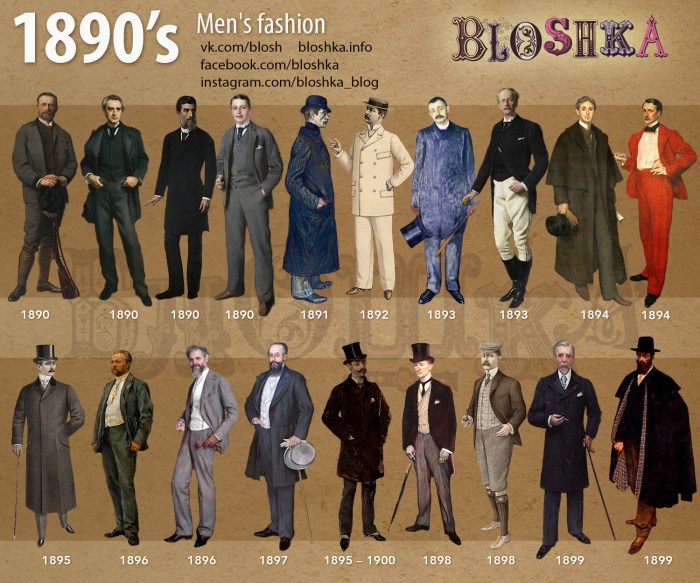1870 Mens Fashion A Gentlemans Style Guide
1870s Men’s Fashion: A Gentleman’s Style
1870 mens fashion – The 1870s witnessed a refined and sophisticated evolution in men’s fashion, characterized by a blend of formality and practicality. This era saw the peak of certain sartorial elements that would soon give way to new trends in the following decades. The overall aesthetic was one of elegance, reflecting both the social standing of the wearer and the prevailing cultural influences of the time.
Overview of 1870s Men’s Fashion
Men’s fashion in the 1870s presented a silhouette emphasizing a strong, broad shoulder line, a defined waist, and full trousers. This created a balanced and elegant appearance. The choice of clothing significantly reflected social class; wealthier gentlemen favored finer fabrics and more elaborate tailoring, while working-class men opted for more durable and less ornate garments. The level of embellishment and the quality of materials served as visual indicators of social status.
A typical outfit for a middle-class gentleman might include a dark-colored frock coat, typically black or dark blue, with a well-tailored fit showcasing a defined waist. Underneath, he would wear a contrasting waistcoat, perhaps in a lighter color or a patterned fabric like paisley. Matching trousers, usually in a dark, solid color, would complete the ensemble. A top hat would be the essential headwear for formal occasions, while a bowler hat might be worn for more casual outings.
Tailoring and Fabrics
The 1870s saw the continued dominance of high-quality natural fabrics. Tailoring techniques emphasized precision and craftsmanship, with skilled tailors creating garments that were both comfortable and stylish. Wealthier individuals could afford bespoke tailoring, resulting in perfectly fitted garments, while those with less disposable income relied on ready-made clothing or local tailors offering less personalized service.
| Fabric | Common Uses | Associated Social Status | Notes |
|---|---|---|---|
| Broadcloth | Coats, trousers | Middle to Upper Class | Fine, durable wool |
| Frieze | Overcoats | Middle to Upper Class | Thick, rough wool |
| Tweed | Suits, trousers | Middle Class | Durable, coarse wool |
| Linen | Waistcoats, shirts | Various | Lightweight, breathable |
Key Garments and Accessories
The frock coat remained a staple garment, featuring a long, often double-breasted design, frequently worn for formal occasions. Waistcoats, or vests, offered a chance for stylistic expression, with variations in fabric, pattern, and embellishment. Trousers were typically full and straight-legged, often featuring a slightly higher waistline. Hats were an indispensable accessory, with the top hat signifying formality and the bowler hat gaining popularity for everyday wear.
- Pocket Watches: Essential timekeeping devices, often carried in a waistcoat pocket.
- Walking Sticks: Functional and fashionable accessories, often crafted from wood or metal.
- Gloves: Made from leather or fabric, offering protection and a touch of elegance.
- Cufflinks and Studs: Small details that added a touch of personal style.
- Scarves and Cravats: Used to add a pop of color and texture to an outfit.
Influence of Culture and Trends, 1870 mens fashion
While specific historical events didn’t drastically alter the fundamental styles of the 1870s, the prevailing cultural climate influenced the overall aesthetic. Artistic movements subtly impacted clothing styles, although the impact was less dramatic than in later periods. Compared to the 1860s, the 1870s saw a slightly more streamlined silhouette, moving away from the more exaggerated proportions of the previous decade.
The transition to the 1880s would witness the beginnings of a shift toward a more relaxed and less structured style.
Imagine a fashionable gentleman at a formal ball. He is impeccably dressed in a black tailcoat, a crisp white shirt with a high collar, and a finely crafted waistcoat of patterned silk. His trousers are dark and neatly pressed, and he sports a top hat perched perfectly on his head. A carefully knotted cravat adds a touch of color to his ensemble, and his polished shoes complete the look.
He carries a slender walking stick and wears elegant gloves.
Evolution of Men’s Fashion from 1860s to 1880s

Source: bloshka.info
The evolution of men’s fashion from the 1860s to the 1880s was gradual but noticeable. The 1860s featured a more exaggerated silhouette, with wider trousers and more pronounced padding in jackets. The 1870s refined this, creating a more balanced and streamlined look. By the 1880s, a shift towards less structured garments and a more relaxed fit began to emerge.
Timeline of Major Shifts:
1860s: Broader shoulders, fuller trousers, more pronounced waistcoats.
1870s: Refined silhouette, emphasis on balanced proportions, introduction of the bowler hat.
1880s: Beginnings of a less structured look, looser fitting garments, early signs of the transition to the more casual styles of the following decades.
FAQ Section: 1870 Mens Fashion
What were common everyday outfits for working-class men in 1870?
Working-class men typically wore sturdy trousers, often made of wool or cotton, paired with a waistcoat and a less formal coat like a sack coat or a reefer jacket. Hats were also essential, with caps being common.
How did the American Civil War influence 1870s men’s fashion?
1870s menswear saw the rise of tailored suits and frock coats, reflecting a more formal societal structure. For modern interpretations and a visual exploration of these styles, check out the diverse range of looks on instagram fashion for men , where you’ll find contemporary takes on classic elements. Many of today’s trends draw inspiration from the elegant silhouettes and refined details prevalent in 1870s men’s fashion.
The aftermath of the Civil War influenced fashion subtly. There was a move towards slightly simpler styles, possibly reflecting a period of economic adjustment. However, the overall Victorian aesthetic remained dominant.
Were there any significant color trends in 1870s menswear?
Darker colors like navy, brown, and black were prevalent, reflecting the overall formality of the era. However, subtle variations in shades and patterns existed, depending on the fabric and social class.





















